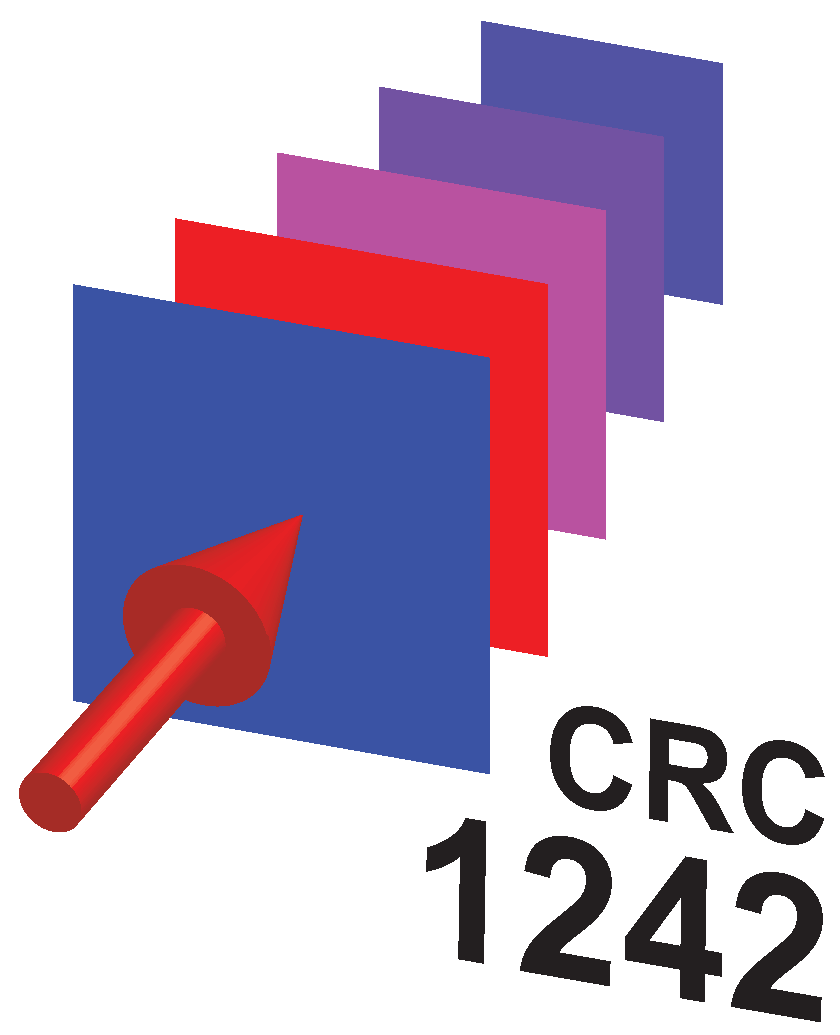HIGH ORDER HARMONIC GENERATION FROM SOLID TARGETS: TOWARDS INTENSE ATTOSECOND PULSES
introduction producing high contrast pulses Particle-in-Cell simulations HOHG Publications
Particle-in-Cell simulations
high contrast pulses
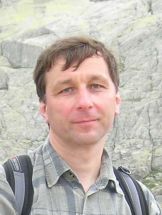
Introduction
The generation of attosecond light pulses offers a spectacular extension to the field of ultrafast science [1- 3]. Such pulses can provide enough temporal resolution for the direct observation of electron motion in nanostructures, molecules, and atom inner shells. At the present time, the established method of producing attosecond pulses is the generation of high order harmonics (HOHG) in rare gases. However, recent theoretical work has suggested that HOHG from solid surfaces can be orders of magnitude more efficient [4-8].
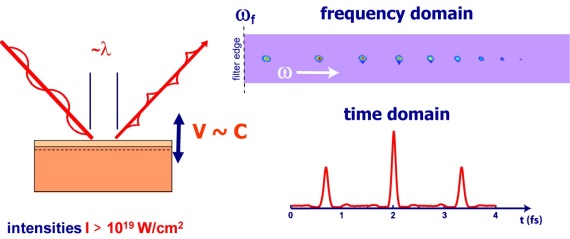
Our research group has a long experience in HOHG from surfaces (Publications) starting from [9]. We investigate the HOHG both experimentally and using particle-in-cell (PIC Further information...) simulations. The harmonics can in principle be generated due to relativistic and/or non-relativistic mechanisms (Further information...). With our laser set-up we can make use of both mechanisms, and we were the first to experimentally demonstrate the transition from one to the other [10].
For the surface HOHG high intensity ultrashort laser pulses have to be used. Our laser set-up is capable of producing high-quality pulses with the intensities up to few times 1019 W/cm2 and 40 fs duration (Further information...). At such intensity the target surface is nearly fully ionized already by the leading edge of the pulse. At the pulse maximum the velocity of the collective oscillations of the surface electrons approaches the speed of light.
Attosecond light pulses can generally be obtained by superimposing several harmonics of the carrier frequency of an intense laser pulse. Increasing the number of harmonics results in shorter pulses, provided that all harmonics are in phase. Generally, however, there are two difficulties in the generation of attosecond pulses using surface HOHG: i) the expected slope of the harmonic spectrum is very steep; ii) there is a certain phase mismatch between the individual harmonic components. In this case in order to produce attosecond pulses the harmonic radiation has to be spectrally filtered, which results in a huge energy loss. We suggest a different approach (zero-cycle attosecond pulses, two-beam HOHG) which allows high efficiency attosecond pulse generation without spectral filtering [11]. Further information...
[1]P. Corkum and F. Krausz, Nature Phys., 3, 381, (2007).
[2] M. Nisoli and G. Sansone, Prog. Quantum Electron., 33, 17 (2009).
[3] F. Krausz and M. Ivanov, Rev. Mid. Phys, 81 , 163 (2009).
[4] G. Mourou et al., Rev. Mod. Phys., 78, 309 (2006).
[5] G. Tsakiris et al., New J. Phys., 8, 19 (2006).
[6] N. Naumova et al., Phys. Rev. Lett., 92, 063902 (2004).
[7] J. Nees et al., J. Mod. Opt., 52, 305 (2005).
[8] S. Gordienko et al., Phys. Rev. Lett., 93, 115002 (2004).
[9] D. von der Linde et al, Phys. Rev. A, 52, R25 (1995).
[10] A. Tarasevitch et al., Phys. Rev. Lett. 98, 103902 (2007).
[11] A. Tarasevitch et al., J. Phys. B, 42, 134006, (2009).
Producing high contrast pulses
The advantages of the conversion to the SH are: i) it is relatively easy and cheap; ii) high repetition rates can be used; iii) the frequency doubling is preferable for the surface HOHG. This makes the SH method more attractive in relatively small university facilities. Some other research groups (e.g. CEA or Rutherford Appleton Laboratory [6,7]) use a different method - a double plasma mirror (DPM) - in order to improve the pulse contrast. This method allows very good contrast ratios, it is frequency and pulse duration independent. The disadvantages are: i) instead of one solid target for HOHG one has to work with three solid targets; ii) the targets are destroyed in each laser pulse and have to be raster scanned in vacuum and regularly replaced. This makes the arrangement complicated and expensive. Although very good contrast ratios can be achieved, using such method is worthwhile primarily in large-scale low-repetition-rate facilities.
[1]A. Tarasevitch et al., Phys. Rev. Lett. 98, 103902 (2007).
[2] A. Tarasevitch et al., J. Phys. B, 42, 134006, (2009).
[3] A. Tarasevitch and D. von der Linde, Eur. Phys. J. Special Topics 175, 35 (2009).
[4] A. Tarasevitch et al., Phys. Rev. E, 68, 026410 (2003).
[5] A. Tarasevitch et al., in: Superstrong Fields in Plasmas, eds M. Lontano, G. Mourou, O. Svelto, T. Tajima, Conference Proceedings 611, (2002).
[6] B. Dromey M. Zepf, A. Gopal et al., Nature Phys. 2, 456 (2006).
[7] C.Thaury et al., Nature Phys., 3, 424 (2007).
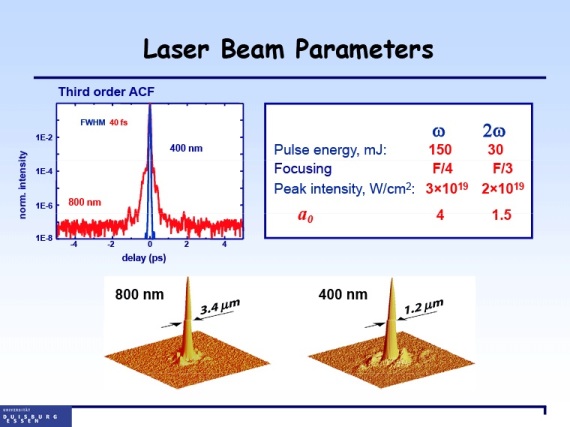
Difraction limited focusing using adaptive optics
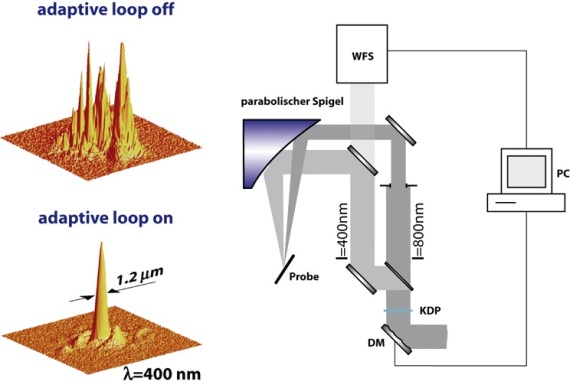
Particle-in-Cell simulations
A. Tarasevitch, R. Kohn
In our simulations we use a fully relativistic PIC-code [Lichters R et al., Phys. Plasmas 3. 3425 (1996)], which treats one spatial and three velocity components (1D3V code). The code was slightly modified so that up to three pulses with independent energies, frequencies, durations, polarizations, and temporal shifts with tespect to one another could be used. Our simulations assume fully ionized targets with a shelf electron density ne0 for x > 0. For x < 0 the plasma vacuum interface can have different density profiles, e.g. an exponential decrease towards the vacuum, ne = ne0 exp(x/L). Here nc is the critical density. The plasma is typically modeled as a 5 to 10λ thick slab within about 15λ long simulation box, 1500-3000 cells/λ, and 100-600 particles per cell corresponding to ne0.
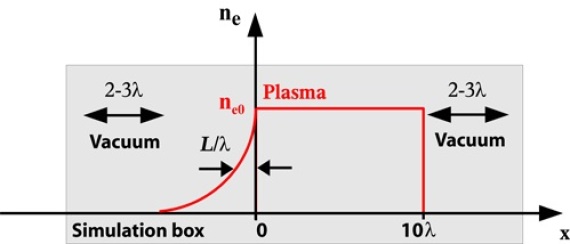
Some examples
Simulation of the plasma density oscillations (left) and their spatially resolved spectrum (right), ne/nc = 49, L/λ= 0.02, a0= 10. |
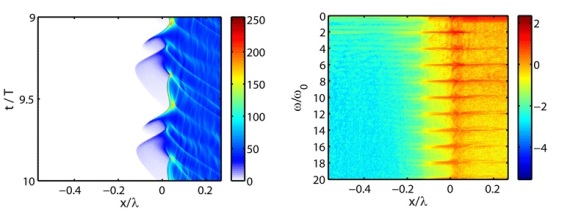
Simulation of reflection of the probe beam from the oscillating plasma (More about driver-probe HOHG...). The plasma oscillations are induced by the driver wave (not shown). The electric field of the incident and reflected waves and the plasma density are shown in red, black and green respectively. Note, that the reflected wave is compressed to attosecond spikes with an amplitude much higher than that of the incident wave.
HOHG Publications
A. Tarasevitch, J. Wieczorek, R. Kohn, U. Bovensiepen, and D. von der LindeHigh Order Optical Harmonic Generation from Solid Surfaces,
Phys. Rev. E, 82, 056410 (2010)
High order harmonic generation from solid targets: Towards intense attosecond pulses,
A. Tarasevitch and D. von der Linde,
Eur. Phys. J. Special Topics 175, 35 (2009).
Towards intense attosecond pulses: Using two beams for high order harmonic generation from solid targets,
A. Tarasevitch, R. Kohn, and D. von der Linde,
J. Phys. B: At. Mol. Opt. Phys. 42, 134006 (2009).
High Order Harmonics from Plasma Surfaces,
A. Tarasevitch, C. Wünsche, and D. von der Linde,
in: Strong Field Laser Physics, ed. by T. Brabec,
Springer Series in Optical Sciences 134, 301 (2008).
Tarasevitch et al. Reply,
A. Tarasevitch, K. Lobov, C. Wünsche, and D.von der Linde
Phys. Rev. Lett. 100, 89402 (2008).
Transition to the Relativistic Regime in High Order Harmonic Generation,
Alexander Tarasevitch, Konstantin Lobov, Clemens Wünsche, Dietrich von der Linde,
Phys. Rev. Lett. 98, 103902 (2007).
3/2 Harmonic Generation by Femtosecond Laser Pulses on Solid Targets,
A. Tarasevitch, C. Dietrich, C. Blome, K. Sokolowski-Tinten, and D. von der Linde
Phys. Rev. E 68, 26410 (2003).
High-Order Harmonic Generation: Towards laser-induced phase-matching control and relativistic effects,
Ph. Balcou, R. Haroutunian, S. Sebban, G. Grillon, A. Rousse, G. Mullot, J-P. Chambaret, G. Rey, A. Antonetti, D. Hulin, L. Roos, D. Descamps, M.B. Gaarde, A. l'Huillier, E. Constant, E. Mevel, D. von der Linde, A. Orisch, A. Tarasevitch, U. Teubner, D. Klöpfel, W. Theobald,
Applied Physics B 74, 509 (2002).
Generation of high order spatially coherent harmonics from solid targets by femtosecond laser pulses,
A.Tarasevitch, A. Orisch, D. von der Linde, Ph. Balcou, G. Rey, J.-P. Chambaret, U. Teubner, D. Klöpfel, and W. Theobald
Phys. Rev. A 62, 023816 (2000)
Probe-field reflection on a plasma surface driven by a strong electromagnetic field,
K. Rzazewski, L. Plaja, L. Roso, and D. von der Linde
Journal of Physics B: Atom. Mol. and Opt. Phys. 33, 2549-2558 (2000)
Beyond the moving mirror model: Attosecond pulses from a relativistically moving plasma,
L. Roso, L. Plaja, K. Rzazewski, and D. von der Linde
Laser and Particle Beams 18, 467-475 (2000)
Diffraction-limited emission of high order harmonics from solid surfaces,
A.Tarasevitch, C. Dietrich, A. Orisch, and D. von der Linde
in: Ultrafast Phenomena XII, ed. by T. Elsaesser, S. Mukamel, M. M. Murnane, N. F. Scherer
Springer Series in Chemical Physics 66, 297 (Springer, Heidelberg, 2000)
Generation of High Order Optical Harmonics from Solid Surfaces,
D. von der Linde
Appl. Phys. B 68, 315-319 (1999)
Generation of High Order Optical Harmonics in Steep Plasma Density Gradients,
D. von der Linde,
in: Superstrong Fields in Plasmas
ed. by M. Lontano, G. Mourou, F. Pegoraro, E. Sindoni,
Conference Proceedings 426, Am. Inst. of Physics, New York (1998)
High Order Optical Harmonic Generation from Solid Surfaces,
D. von der Linde and K. Rzazewski,
Appl. Phys. B, 63, 499 (1996)
Generation of Ultrashort XUV Pulses by Harmonic Generation from Solid Surfaces,
D. von der Linde, T. Engers, G. Jenke, P. Agostini, G. Grillon, E. Nibbering, J.-P. Chambaret, A. Mysyrowicz, and A. Antonetti,
in Laser Optics '95 and ICONO '95: Superintense Laser Fields, ed. by A.A. Andreev, V.M. Gordienko,
SPIE Proceedings 2770, 98-105 (1996)
Generation of High Order Harmonics from Solid Surfaces by Intense Femtosecond Laser Pulses,
D. von der Linde, T. Engers, G. Jenke, P. Agostini, G. Grillon, E. Nibbering, J.-P. Chambaret, P. F. Curley, A. Mysyrowicz, and A. Antonetti,
in: Ultrafast Processes in Spectroscopy, ed. by O. Svelto, S. De Silvestri, and G. Denardo, p. 319, (Plenum Press, London, 1996)
Harmonic Generation from a Sharp Plasma-Vacuum Boundary,
D. von der Linde, T. Engers, G. Jenke, P. Agostini, G. Grillon, J.-P. Chambaret, A. Mysyrowicz, and A. Antonetti
in: Ultrafast Phenomena X, ed. by P. F. Barbara, J. G. Fujimoto, W. H. Knox, W. Zinth, in Springer Series in Chemical Physics 62, p. 117, (Springer Verlag, Heidelberg, 1996)
Harmonic Generation in Femtosecond Laser-Produced Plasmas,
D. von der Linde,
in: Notions and Perspectives of Nonlinear Optics, ed. by O. Keller, p. 234, (World Scientific Publ., London,1996)
Generation of High Order Harmonics from Solid Surfaces by Intense Femtosecond Laser Pulses,
D. von der Linde, T. Engers, G. Jenke, P. Agostini, G. Grillon, E. Nibbering, A. Mysyrowicz, A. Antonetti,
Phys. Rev. A, 52, R25 (1995)


